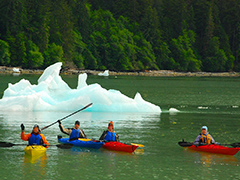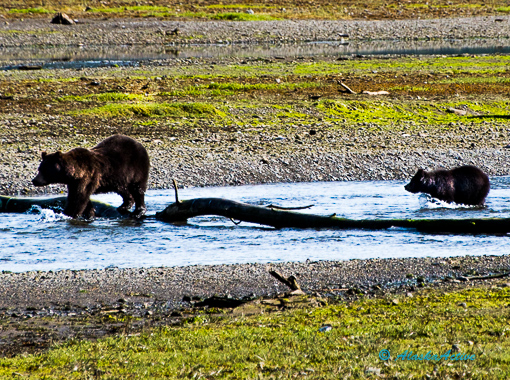|
The Tlingit People call the island Kootznoowoo - "Fortress of the Bears." Admiralty Island is a lush rainforest wilderness with the world's largest population of nesting bald eagles and more brown bears per square mile than anywhere in the world. You will not easily forget the "Fortress of the Bears" once you have camped under its lush canopy, paddled sea kayaks along its shores, explored its ancient forests, and watched its brown bears feasting on migrating salmon. This rainforest paradise is the crown jewel of the Tongass National Forest. Our July and August trips coincide with the bountiful annual salmon runs, creating superb bear watching opportunities. In June, watch for bears grazing in the meadows adjacent to Pack Creek. The trip includes the much sought-after permits to visit the world-famous Stan Price Bear Sanctuary at Pack Creek, where we spend a full day watching for brown bears as they lope up and down the creek in pursuit of salmon. Due to limited permits for the bear sanctuary, these trips fill early. Begins and ends in Juneau. |
GBM#01 Bears of Admiralty Island Kayak Tour | Pack Creek
Tour Itinerary
Dates | Rates
|
Day
01 |
  |
Juneau - Admiralty Island, Pack Creek Pack Creek bear viewing on Admiralty Island is an experience not to be missed. Enjoy a thrilling ride in a float plane, spot brown bears in the wild, and enjoy a coastal paddle in a sea kayak on this full-day excursion filled with fun and adventure. Juneau is bear country, and the very best place to view the coastal-dwelling, salmon-eating brown bears in the wild is Admiralty Island, also known as The Fortress of the Bears. This wilderness island is home to one of the highest-density brown bear populations on the planet, as well as to a large population of nesting bald eagles. Admiralty Island bear viewing is a great experience for the whole family, as you can observe these furry giants up-close in a beautiful wilderness habitat. In salmon-spawning season, you may even see bears catching salmon with their claws or in their mouths as the salmon swim upstream to mate. For this tour, your group will fly into Windfall Island before paddling to the shores for Pack Creek bear viewing. After a 20-minute flight, your float plane will land on the shores of Windfall Island, where you’ll sea kayak along the coast to Pack Creek to observe the bears and learn about their habitat and behavior from your knowledgeable guides. Then it’s time for a relaxing and delicious lunch on the beach before the return journey to Juneau. Your eight-hour round-trip Admiralty Island bear viewing experience begins with pick-up right at the Juneau cruise docks followed by transportation to the float plane base. After your gear-fitting and safety instructions are finalized, it’s time to board the float plane for the 20-30 minute flight to Admiralty Island for Pack Creek bear viewing, where you can view brown bears from an observation tower, and for Windfall Island, a remote and rugged outpost. On your sea kayak paddle along the tranquil coastline toward your bear-viewing destination, keep an eye out for seals, humpback whales, and on-shore wildlife like minks, martens, and deer. At the conclusion of your visit to The Fortress of the Bears, a delicious picnic lunch will be served on the beach before you paddle back to your float plane for the flight back to Juneau and transportation back to the cruise docks. Admiralty Island bear viewing is the most exclusive Juneau tour we offer, and it’s a true Alaskan wilderness experience you will never forget! Please note: Kayaking is only included from June-August. In May & September a direct flight is taken to the Pack Creek area to maximize bear viewing time. |
| Rates in US $ / per Person | Adult |
| Admiralty Island Fortress of the Bear Kayak Tour | $ 939.00 |
| Daily from May 15 - September 15 |
|
